Michigan Presidential Primary: Voter Maps
Michigan’s Republican presidential primary held on Tuesday, Feb. 28 was won by Mitt Romney, with 41% of the Republican votes cast statewide – a close victory over Rick Santorum, who tallied 37.9%. Third-place finisher Ron Paul came in with 11.5%, roughly double the percentage he received in the 2008 edition of the race, which was won by Romney that year as well. The eventual Republican nominee in 2008, of course, was John McCain.
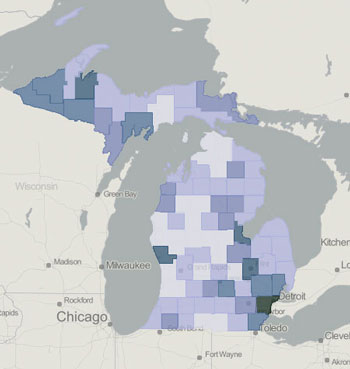
Map 1. Michigan 2012 presidential primary election – Democratic participation as a percentage of total turnout, by county. Details after the jump.
For Democrats, President Barack Obama was unchallenged in the Michigan primary this year, amid a political scuffle about whether the Democratic primary should even be held. With little at stake in terms of the choice of the Democratic nominee, it’s not surprising that the 2012 Democratic turnout was light, compared to 2008.
This year only 16% of participants in the primary voted on the Democratic side compared with 40% in 2008. That year Obama’s name did not appear on the Michigan ballot, which resulted in about 41% of Democratic voters selecting the “uncommitted” option, compared to roughly 55% who voted for Hillary Clinton. Part of the diminished Democratic turnout this year could have been due to Democrats crossing party lines to vote for Rick Santorum – based on the idea that Santorum would have less of a chance to defeat Obama in the general election.
In Ann Arbor, however, absentee Democratic voters participated in far greater relative numbers than their counterparts who went to the polls in person. Even in the more strongly Republican wards – Ward 2 and Ward 4 – almost 40% of the total primary turnout for absentee voters was on the Democratic side. In the other three Ann Arbor wards, Democratic absentee turnout was closer to 50%.
For readers already familiar with the general geographic distribution of voters who mainly vote Democrat or Republican, the results of the 2012 presidential primary in Michigan likely offer little to refute prevailing wisdom.
After the jump we take a geographic look at Democratic participation, as well as the performance of Romney, Santorum and Paul. We’ve mapped out results at the state level (by county), the Washtenaw County level (by township and city) and the city of Ann Arbor (by precinct). Statewide data is from the secretary of state’s office election results, while the data for jurisdictions within Washtenaw County is based on the county clerk’s election results. Mapping is done through geocommons.com with shape files available through the city of Ann Arbor.
Dynamic Maps
Maps created by The Chronicle include results for the 2008 and 2012 presidential primaries – for Democratic turnout (and by implication Republican turnout), the performance of Romney, Paul and Santorum. (Santorum’s results are for 2012 only, because he didn’t run in 2008.)
Links to the dynamic maps generated on geocommons.com:
- Michigan, results by county
- Washtenaw County, results broken down by township and city
- Ann Arbor, results by precinct
For each map, different results are presented in different “layers,” which can be controlled on the right side of the screen. To view different results, first “uncheck” the box of the layer currently displayed, and check the box of a different layer.
Below we present a selected set of static images from those dynamic maps.
Michigan Dems
Compared to 2012, relative turnout among Democrats across the state in 2008 showed a geographic pattern similar to that in Map 1. Although the relative strength of Democratic turnout was roughly similar in those two years, many more counties were relatively week this year, compared to 2008, and fewer counties were relatively strong.

Map 1. Michigan 2012 presidential primary election – Democratic participation as a percentage of total turnout, by county. The darkest shade of blue (Wayne) reflects 33% turnout. The lightest shades (e.g. Ottawa and Allegan) reflect around 5% Democratic participation.
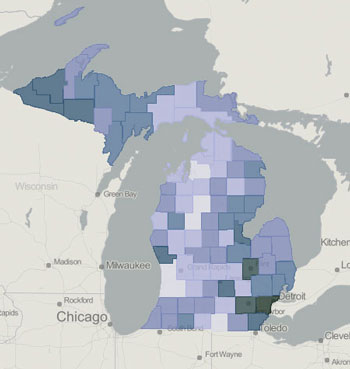
Map 2. Michigan 2008 presidential primary election – Democratic participation as percentage of total turnout, by county. The darkest shade of blue (Wayne) reflects 62% Democratic turnout. Neighboring Washtenaw had 50% Democratic turnout. The lightest shades correspond percentage-wise to the high-teens and lower 20s. Ottawa, on the western side of the state, had just 17% Democratic participation.
Michigan: Republican Candidates
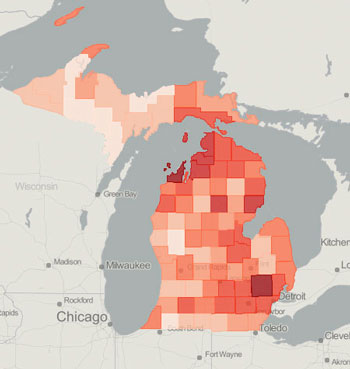
Map 3. Mitt Romney's performance in the 2012 Michigan presidential primary election, by county. Romney had a bit over 41% of the statewide vote. He was strong in the southeastern part of the state, in particular in Oakland County, where he received a bit over 50% of the vote.
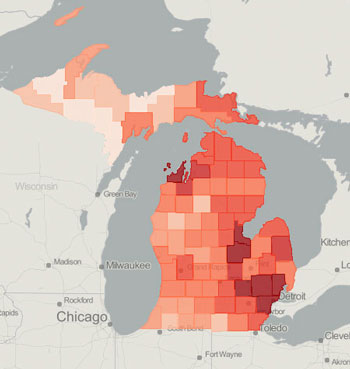
Map 4. Mitt Romney's performance in the 2008 Michigan presidential primary election, by county. That year, Romney had about 39% of the vote statewide. As in 2012, he was strong in the southeastern part of the state, polling more than 44% in Livingston, Oakland, Macomb and Wayne counties that year.
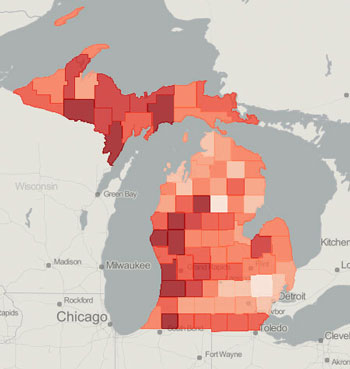
Map 5. Rick Santorum's performance in the 2012 Michigan presidential primary election, by county. Statewide, he received 37.9% of the vote. He received more than 49% of the vote in several of the western counties.
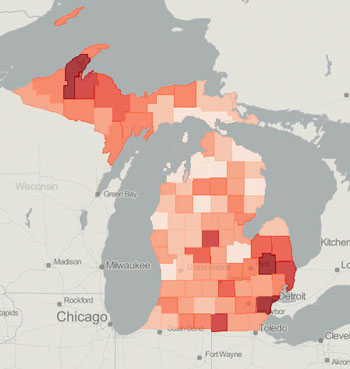
Map 6. Ron Paul's performance in the Michigan 2012 presidential primary election, by county. Paul received 11.6% of Republican votes statewide. Support was strongest in Lapeer and Wayne counties with around 16% of voters supporting Paul. On the low side were counties like Ottawa, where Paul tallied around 8.5% of the vote. Paul's support across the state was more uniform in 2012 than in 2008. (See Map 7.)
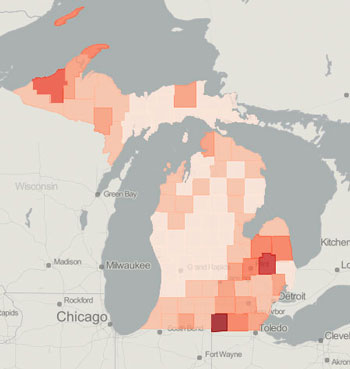
Map 7. Ron Paul's performance in the Michigan 2008 presidential primary election, by county. Paul tallied 6.2% of the vote statewide that year. He was strongest in Hillsdale County (in the south), getting nearly 17% of the vote.
Washtenaw Dems
The Democratic turnout in Washtenaw County in 2012 compared to 2008 was a similar story to the statewide picture. Both years, Democratic turnout was strongest where it would ordinarily be expected – in the eastern part of the county. But diminished participation translated into fewer townships at the strongest levels of support.
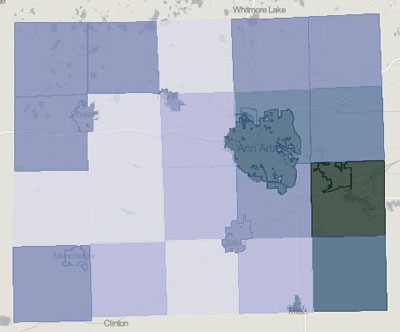
Map 8. Washtenaw Democratic participation in the Michigan 2012 presidential primary election as a percentage of total turnout, by township and city. Ypsilanti Township, with 28% participation, had the highest in the county. The city of Ypsilanti had 24%, while the city of Ann Arbor had 17%. Townships with the lowest Democratic turnout, like Saline Township in the mid-south, had low single-digit Democratic turnout.

Map 9. Washtenaw Democratic participation in the Michigan 2008 presidential primary election as a percentage of total turnout, by township and city. The city of Ypsilanti had the highest Democratic participation, with 65%, followed by the city of Ann Arbor with 63%.
Washtenaw: Republican Candidates
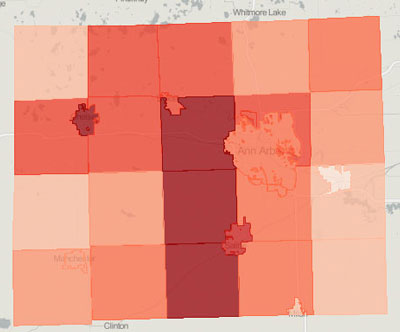
Map 10. Mitt Romney's performance in Washtenaw County in the 2012 Michigan presidential primary election. Countywide, Romney had 42% of the vote. He was strongest in the middle swatch of townships, and the city of Chelsea, where he tallied better than 50% of the vote. He was weakest in Ypsilanti, where he received 29% of the vote.
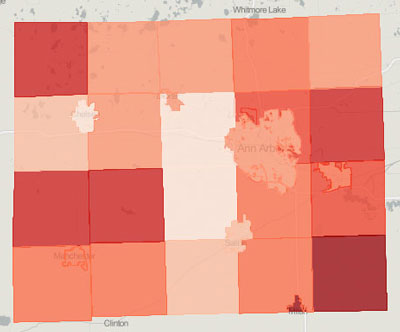
Map 11. Rick Santorum's performance in Washtenaw County in the 2012 Michigan presidential primary election. Countywide, Santorum had 37% of the vote. He was strongest in August Township (lower righthand corner) with 47% of the Republican vote. He had 45% of the Republican vote in Lyndon Township (upper lefthand corner). He was weakest in the geographic center of the county in Scio and Lodi townships, where he received about 31% of the vote.

Map 12. Ron Paul's performance in Washtenaw County in the 2012 Michigan presidential primary election. Countywide, he almost 16% of the vote. He was strongest in the city of Ypsilanti, where he received 29% of the Republican vote. He was weakest in townships like Saline, where he received just over 5% of the vote.
Ann Arbor Dems
Compared to the 2008 turnout in the city of Ann Arbor, when the outcome of the nomination process for both parties was somewhat uncertain, the Democratic turnout in the city of Ann Arbor is somewhat of a mixed bag.
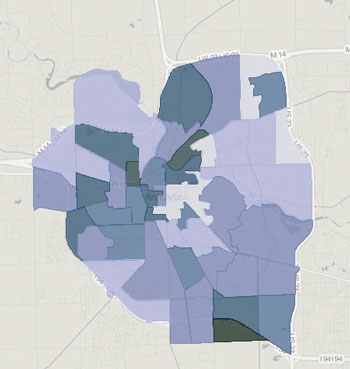
Map 13. Ann Arbor Democratic participation as a percentage of total turnout in the Michigan 2012 presidential primary election. Democratic participation was strongest in Ward 3, Precinct 5 in the south of the city, with about 18% of the total turnout.

Map 14. Ann Arbor Democratic participation as a percentage of total turnout in the Michigan 2012 presidential primary election. In the strongest precincts, Democratic turnout ranged between 70-80%, while in even the weakest precincts, it was around 50%.
Ann Arbor: Republican Candidates

Map 15. Mitt Romney's performance in Ann Arbor in the Michigan 2012 presidential primary race. In the traditionally strong Republican precincts of Ward 2, Romney's support ranged from 54% to 63%. In other precincts, his percentage was mostly in the low 30s.
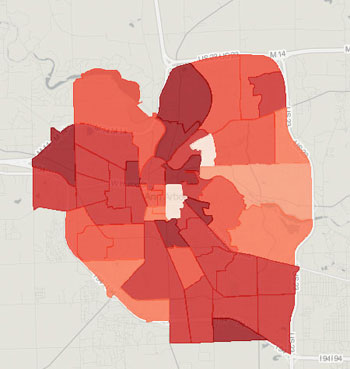
Map 16. Rick Santorum's performance in Ann Arbor in the Michigan 2012 presidential primary race. Santorum was strongest in precincts that as a whole do not tend to enjoy strong Republican support. In Ward 1, Precinct 10 in the central north of the city, he got 53% of the Republican vote, and in Ward 3, Precinct 6 he received 44% of the vote. In traditional strong Republican precincts of Ward 2, he received percentages in the low to mid-20s.
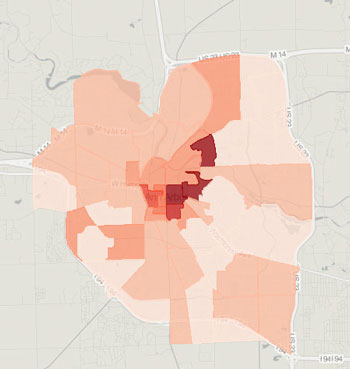
Map 17. Ron Paul's performance in Ann Arbor in the Michigan 2012 presidential primary race. Percentage-wise, Paul was strongest in the center of the city, where he tallied more than half the Republican votes – but the raw numbers were in some cases in the single digits. In the next-strongest areas, he typically had percentages in the mid-20s.
The Chronicle could not survive without regular voluntary subscriptions to support our coverage of local government and civic affairs. Click this link for details: Subscribe to The Chronicle. And if you’re already supporting us, please encourage your friends, neighbors and colleagues to help support The Chronicle, too!




These maps are pretty to look at, but don’t tell you anything. In order to see the actual numbers, go to the web site of the County Clerk at http://www.ewashtenaw.org and click on elections. There you will see that, in Ann Arbor, it was an extremely low turnout. The actual numbers for each candidate are there as well. That will give a much better picture of what actually happened.
I wouldn’t say that the maps don’t tell anything. However, this might have been the time to include two pieces of information on the map. The color ramp could show the percentage distributions, while raw totals could be indicated by hash marks (dots, lines, etc.).
Apparently, one of Santorum’s strategies in Michigan was to concentrate on some Congressional Districts that were not Republican leaning. Winning those counted just as much as winning a Republican Congressional District, albeit based on fewer Republicans.
I am struck by how few voters in each state are deciding the presidential candidate.
Dr Data, question for you since you seem to have a handle on all things demographic.
Is there any significance to poll closing times in various states, and how that state skews liberal vs conservative? I think Indiana closes at 7 PM as a rule, and always seems to vote more Republican as opposed to neighboring states that close their booths at 8 PM.
I’m not an expert on voting rights, but in general, I think jurisdictions that make it easier for folks to vote will tend to be more liberal/progressive than areas with more restrictive voting rules. This can be voting day registration, internet voting, absentee voting for all – not just the elderly/disabled, primaries on Saturdays, and extended hours.
There is currently a pretty strong push to tighten up voting rules presumably to prevent voter fraud. In the end, this will likely hurt Democrats.